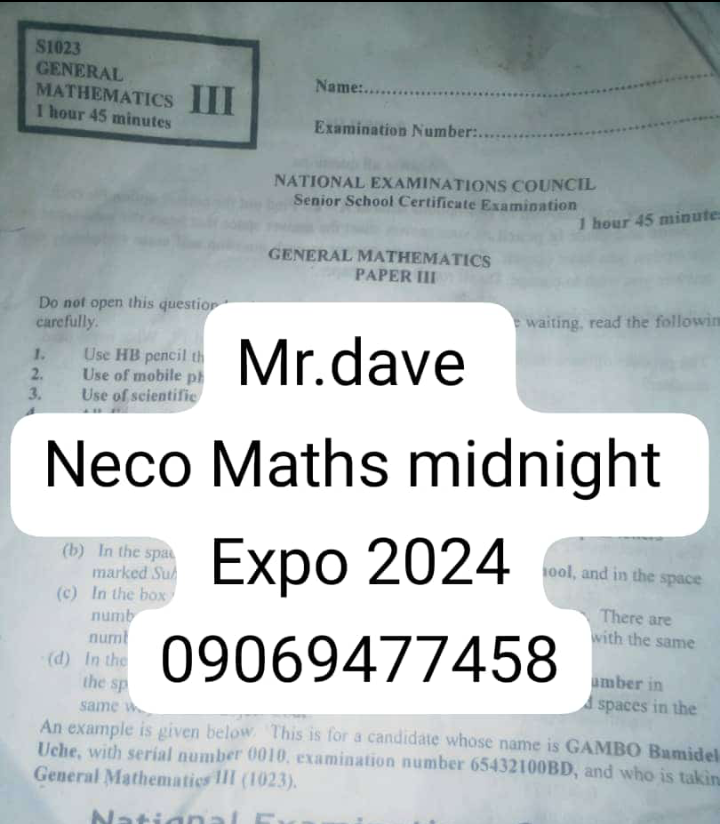*NABTEB GCE COMMERCE SOLUTIONS
COMMERCE OBJ
1-10: CACDBAAAAC
11-20: ABCCCCCCAD
21-30: BAAABDDAAB
31-40: AAABBCCBDC
41-50: CBABABCBCC
*INSTRUCTION:* ANSWER FIVE (5) QUESTIONS ONLY
(1a)
Sales promotion can be defined as a marketing strategy where the product is promoted using short-term attractive initiatives to stimulate its demand and increase its sales.
(1b)
(i) Discounts: This is the most common method in which the products are offered at lower prices than the market price. For example, the washing machine may be listed at ₦50,000 but after the discount of 10%, it may be sold at ₦45,000.
(ii) Product combinations: This is a unique method to boost sales. A gifted product is offered along with the main product. For example, the toothbrush is offered along with the toothpaste or pen is offered along with the notebook, etc.
(iii) Lucky Draw:
Under this method, the customers of a particular product are offered gifts on a fixed date and the winners are decided by the draw of lots. While purchasing the product, the customers are given a coupon with a specific number printed on it.
(iv) Instant Draw and Assigned Gift:
Under this method, a customer is asked to scratch a card on the purchase of a product and the name of the product is inscribed thereupon which is immediately offered to the customer as a gift. For example, on buying a car when the card is scratched such gifts are offered TV, Refrigerator, Computer, Mixer, Dinner Set, Wristwatch, T-shirt, Iron Press, etc.
(v) Samples or Sampling:
Under this method, the producer distributes free samples of his product among the consumers. Sales representatives distribute these samples from door-to-door. This method is used mostly in case of products of daily-use, e.g., Washing Powder, Tea, Toothpaste, etc
==============================
(2a)
Trade is the buying and selling of goods and services, while Commerce is involved in all those activities in the distribution and exchange of goods and services.
(2b)
(i) Transfer of information: Commerce aids the receiving and giving out of business and non-business which is vital to human existence. Trade is promoted globally through the dissemination of information, that is both oral and written.
(ii) Effective distribution: Equitable distribution and supply of goods in and around the world are ensured through commerce. It helps products to be made available where they are needed thereby preventing scarcity and fluctuation in the prices of goods.
(iii) Large scale production: Commerce helps to encourage mass or large scale production of goods both at local and foreign levels hence there is an expansion of market or the product.
(iv) Stimulation of demands: Commerce plays a role of increasing demand through effective advertising strategy which helps to expand the market for local and international products.
(v) Risk minimization: Insurance helps to cover all forms of losses both physical and financial that may occur in businesses thereby ensuring rapid growth in the world market.
==============================
(3a)
Transportation is the process of conveying goods and people from one place to another either through water, road, rail or air.
(3b)
(i) Type of goods/nature of goods
(ii) Availability
(iii) Owner’s choice/convenience
(iv) Cost of the mode
(3c)
(i) Type of goods/nature of goods: This covers the nature of the goods, fragile and perishable goods can be sent through air transport while heavy and bulky goods can be sent by rail.
(ii) Availability: The choice of transport would be determined by the means of transport that exists in a particular place at a particular time.
(iii) Owner’s choice/convenience: This has to do with choice which may be as a result of the class of the owner. Rich people prefer air even for items that can go by road.
(iv) Cost of the mode: The cost of using a particular means may affect the use of the means. It is more costly to travel by air.
==============================
(4a)
(i) Memorandum of Association
(ii) Article of Association
(iii) Prospectus
(iv) Certificate of Incorporation
(v) Certificate of Trading
(4b)
(i) Memorandum of Association: It is a document forming the constitution of a company and defining its objectives and powers with regard to its dealing with the outside world. It is the document containing the rules and regulations which govern the external relationship of a company with outsiders.
(ii) Article of Association: It is a document in which the regulations which govern the internal management of the company’s affairs, duties, rights and powers of the shareholders are stated. It complements the memorandum of association
(iii) Prospectus: It is a document issued by the public limited companies only inviting the public to subscribe for shares of the company. A copy of such a prospectus, signed by the directors or proposed directors in writing, must be filed with the registrar of companies.
(iv) Certificate of Incorporation: This is a certificate which is given out as evidence that all the requirements have been complied with by the company and is therefore duly registered under the Act. The certificate of incorporation contains name of the company, registration number and signature of the registrar.
(v) Certificate of Trading: This is a document which allows the public limited liability company to commence business activities. It is issued to enable public limited liability company commence operation after the company has been given the certificate of incorporation.
==============================
(5a)
(i) Invisible Trade: This is a type of international trade involving intangible products such as services or banking, shipping services which require payment of money.
(ii) Entrepot Trade: This is a system of trade where goods imported into a country are re-exported while the goods are still in the same form as they were received.
(iii) Import Trade: This is a system of trade where goods produced in one country are brought into another country for sale.
(5b)
(i) Trade restrictions by countries being created by trading partners when they discover they have adverse balance of trade or payment such as embargoes, duties, quota, cartel.
(ii) Difference in Business laws and regulations among countries.
(iii) Government policies/political differences can affect trade between two countries.
==============================
(6a)
(i) Open Market Operation
(ii)Reserve Requirement/Liquidity/Cash Ratio
(iii) Moral suasion
(iv) Bank rate
(v) Special deposit
(6b)
(i) Open Market Operation: This is a method used to either increase or reduce the money in the hands of commercial banks for lending purpose. To increase the money in circulation, the Central Bank will buy instruments (Treasury certificate and Treasury bills) and pay with cash while it sells instruments to reduce money.
(ii)Reserve Requirement/Liquidity/Cash Ratio: This represents the amount a commercial bank must keep as reserve from her deposits. This will be kept low or high to encourage or discourage lending by commercial banks. There are two types of reserves; namely cash ratio and liquidity reserve.
(iii) Moral suasion: This is more of an appeal to commercial banks to keep within the rules as stipulated by the Central Bank.
(iv) Bank rate: This is referred to as the minimum rate for lending as stipulated by the Central Bank. The rate will be kept high to discourage people from borrowing and encourage savings, while the rate will be kept low to encourage borrowing.
(v) Special deposit: This refers to compulsory deposits demanded by the Central Bank which is pegged as a percentage of total deposits to reduce the lending activities of commercial bank.
==============================
(10a)
A current asset is a company’s cash and its other assets that are expected to be converted to cash within one year of the date appearing in the heading of the company’s balance sheet
(10b)
(i) It serves as a yard stick for investors.
(ii) Serves as a check against tying down too much money for current assets.
(iii) It is used for financing the daily transactions of a business.
(10c)
=ADVANTAGES=
(i) It is easy to set up and organize.
(ii) One-man business is suitable for the provision of personal services and production of special or custom-made products.
(iii) Cordial relationship with customers provides a feedback system that can help assist in maximum satisfaction of customers.
(iv) The owner enjoys independence since he is his own boss.
(v) Decision taking is quick since the owner does not need to consult anybody.
=DISADVANTAGES=
(i) There is limited capital for expansion purposes. This is partly due to the inability of the owner to borrow money from banks.
(ii) The sole proprietor has unlimited liability as his personal assets can be sold in case of business failure.
(iii) The business is not a separate legal entity, therefore, it cannot sue or be sued.
(iv) Sole proprietor business lacks the certainty of continuity because the death of the owner or poor management can result in the death of the business.
==============================
Categories: Uncategorized



